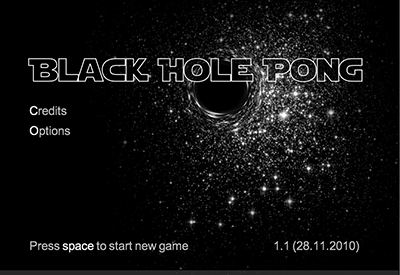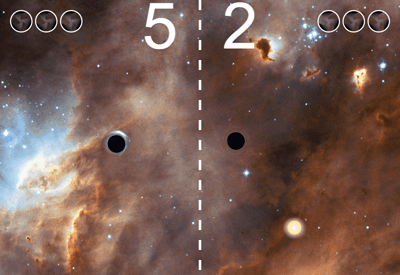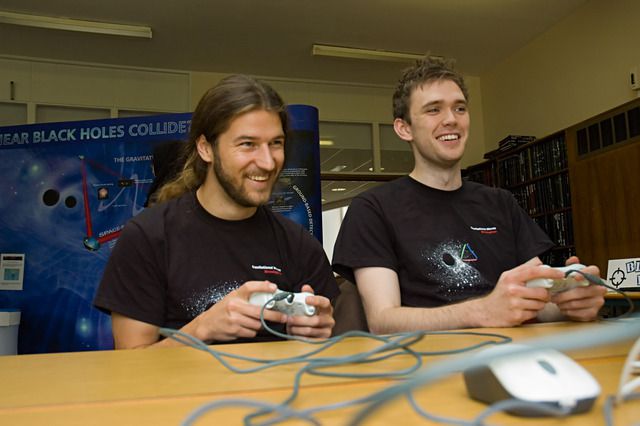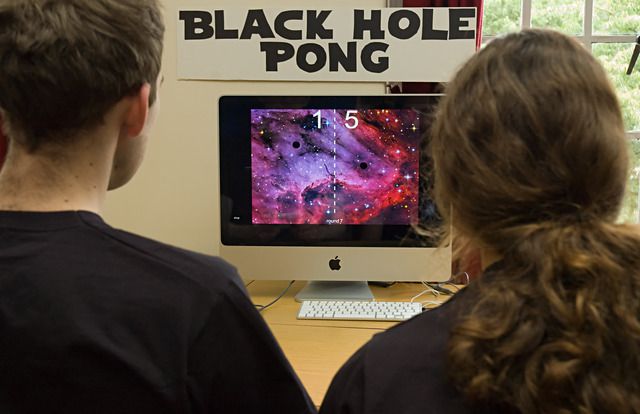Black Hole Pong
(A Processing game)
summer project
2010
We are making a new edition of this game: Black Hole Master.
This game is a light-hearted remake of the old classic, except with a cosmic twist! The original game of Pong involved each player controlling a paddle which they would use to bounce a ball back to their opponent, in the hope they would miss. Each time the ball touched the opponent's side of the screen, the player would win a point.
In this remake, each player now controls a black hole! The objective; to position their black hole on their side of the screen and utilise its gravitational potential to fling an approaching star back. Whoever lets a star slip past loses!
If you want to know more about how we are using large laser interferometers to look for astronomical signals from black holes, have a look at our Ebook on graviatational wave detection!

|

|
This program is provided as a stand-alone application (not as an applet that runs in a browser). To run this application please download the appropriate file, unzip it and start the executable in the BlackHolePong folder. You must have a 32bit version of Java installed for the application to work. The game has been tested only on Mac OS 10.5, 10.6 and Windows XP. A Linux version might be added later.
- BlackHolePong_OSX.zip: binary for Mac OS (23 MB)
- BlackHolePong_Windows.zip: binary for Windows (22 MB)
The video below shows a short trailer of the game. For more games, see also our Space Time Quest.
When you have played the game we would like to get some feedback from you. Maybe you can spend 2 minutes to answer this very short questionnaire? Thanks a lot!
Unlike the original Pong where each player was limited to moving their paddle in one dimension, each player can now position their black hole anywhere on their side of the screen. Each black hole has a truncated inverse square law force, allowing the player to influence the trajectory of an incoming star and (hopefully) sling-shot it back towards their opponent. A player scores a goal whenever the star escapes through the back of their opponent's side of the screen. After each goal the game resets and a new star appears in the middle of the screen.
ControlsThe game is for two players only, in other words, you cannot play against the computer (yet). Each player can control the position of his/her black hole within his/her side of the screen. The range of the gravitational force of each black hole can be increased temporarily (by pressing the correct button). At a later stage in the game each player will be equipped with three 'worm holes'; these exhibit completly fictional behaviour, but should be fun. Try them out!
To control the black hole you can use Xbox controllers connected by USB, a normal mouse (in the Mac OS version) or the keyboard:
Xbox controller:- the left hand stick controls the position of the black hole
- the upper left button increases the range of the gravitational potential
- hold down the right hand shoulder button for a while to initiate a worm hole
- the mouse position controls the position of the black hole
- the left button increases the range of the gravitational potential
- press the right button for a while to initiate a worm hole
- one player uses the arrow keys to move the black hole, ENTER for increasing the gravitational range and BACKSPACE to activate the worm hole
- the second player uses A,S,D and W to move the black hole, TAB for increasing the gravitational range and '1' to activate the worm hole
The boundaries of the screen which do not act as goals have an infinite potential wall along with a small damping factor. This contains the star in the screen (as with the original game of Pong) but also decreases the speed of the star by a small fraction each time it bounces off a wall, ensuring the game does not get too out of hand!
Unlike the original which utilises the intuitive nature of elastic collisions between a ball and paddle, this game requires understanding of how gravitational potentials behave. Each black hole has an attractive force on the star which decays with seperation distance according to an inverse square law. This is similar to how a star would be affected, at a distance, by the gravitational field of an object much more massive than itself. The game helps people to understand the concepts of orbital mechanics; in order to fling a star back, try to position the black hole so that the star passes just off centre. The closer the star and black hole pass each other, the stronger the force and the greater the deflection. If the distance of closest approach is increased the deflection will appear more and more gentle until hardly noticeable. These are all examples of stars with escape velocities, producing hyperbolic orbits. It is also possible to capture stars by approaching them from behind. This causes the star to decelerate to the point at which it is travelling below escape velocity, entering a bound, elliptical, orbit around the black hole. Timing is essential when removing the black hole from the orbit or you may just hurl the star towards your goal!
One may also notice a distortion of the background image around the black holes, this is actually a realistic phenomenon called Gravitational Lensing! The intense strength of the gravitational field of a black hole is sufficient to bend light around it, in a similar manner to a lens. This allows an observer to view what is behind a black hole as it appears as a strectched image around its edge!
The game has been a great success during the exhibition Looking for Black Holes with Lasers at British Science Festival in Birmingham, see some example photos below.


The game was started during my summer project at the Gravitational Wave Group Birmingham, UK and then completed later by Andreas Freise. See also our other Processing examples.

